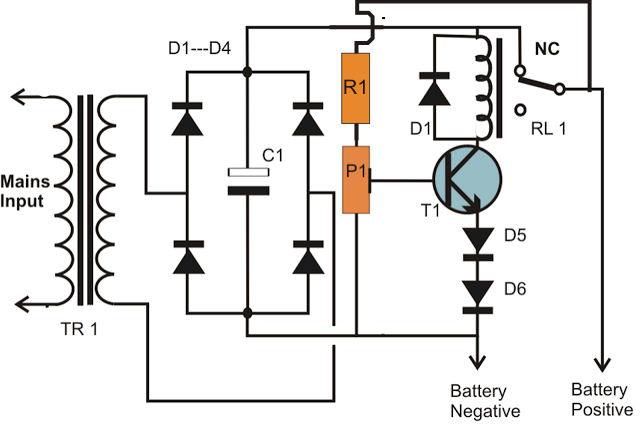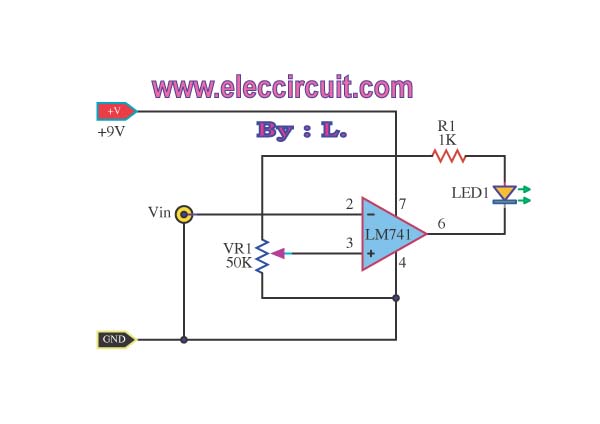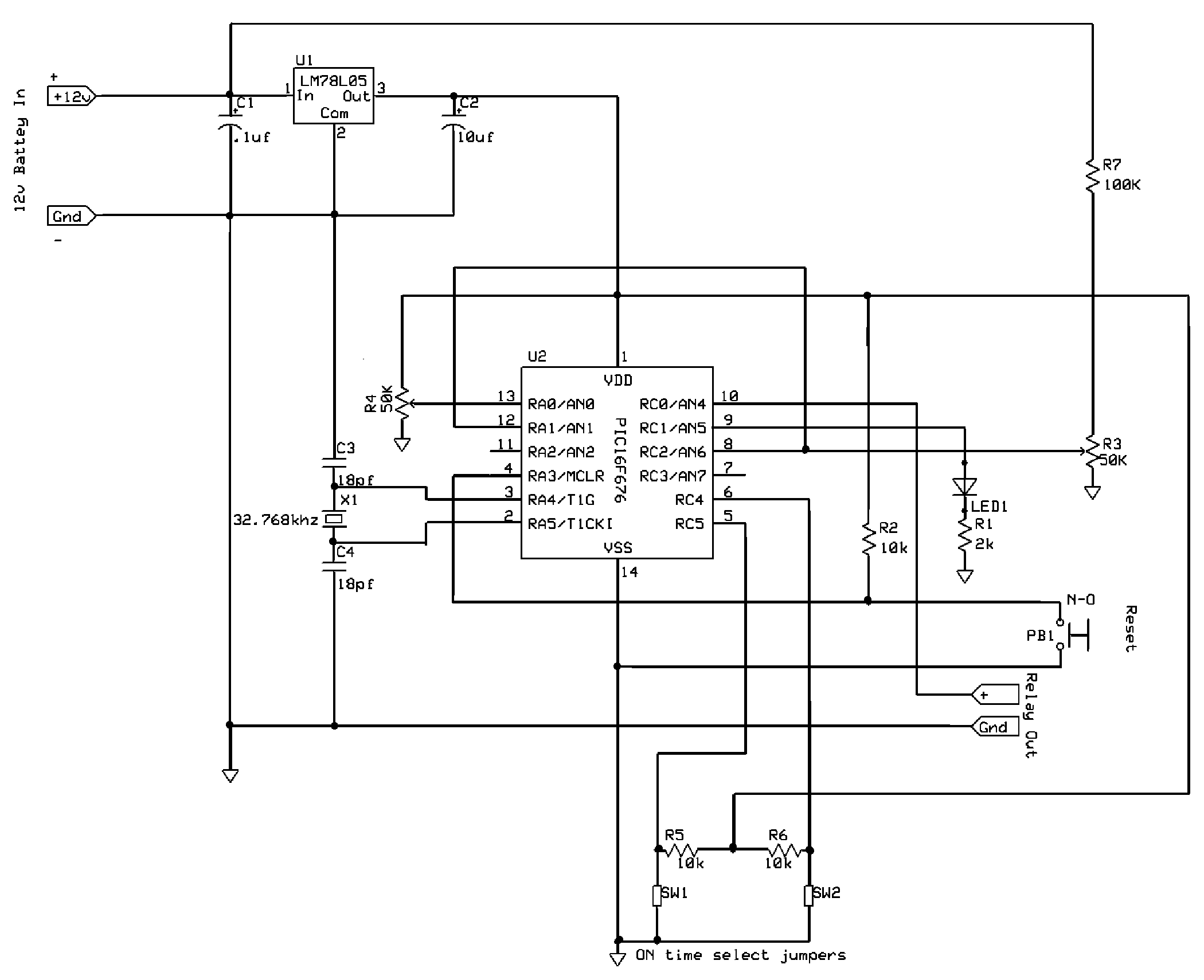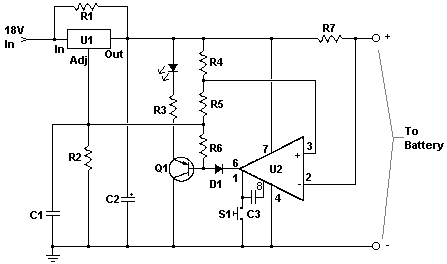
AA Battery Solar Charger
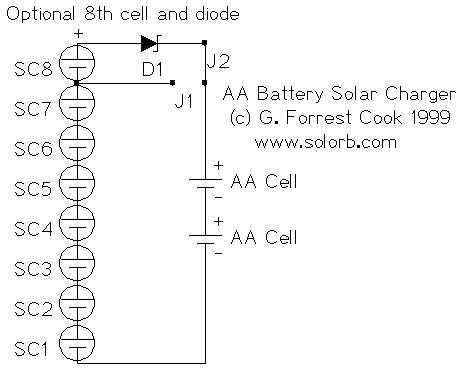
This almost trivial circuit may be used to charge a pair of AA or AAA sized rechargeable battery cells from sunlight. The circuit has been used to keep a Palm Pilot and walkman radio running perpetually. This is an unregulated charger, proper charging is achieved by placing the unit in the sun for a known amount of time, this time varies according to the battery type. More: Each of the solar cells develops about 0.5 volts across itself when in full sunlight. The string of 8 solar cells puts out around 4V with no load. When the solar cells are connected to a battery, a current will flow and the battery will charge.
The described circuit utilizes a series configuration of eight solar cells, each generating approximately 0.5 volts under optimal sunlight conditions. This arrangement yields a total open-circuit voltage of about 4 volts, which is suitable for charging rechargeable AA or AAA batteries. The circuit operates as an unregulated charger, meaning that it does not include any voltage regulation components to maintain a constant output voltage.
In practical applications, the user must monitor the charging duration based on the specific battery chemistry utilized, such as NiMH or NiCd, as different batteries have varying charge acceptance characteristics and optimal charging times. The lack of regulation implies that the circuit is simple and cost-effective, but it also necessitates careful management to prevent overcharging, which could damage the batteries.
The solar cells should be positioned to maximize exposure to sunlight, ideally facing south in the northern hemisphere or north in the southern hemisphere, at an angle that corresponds to the latitude of the installation site for optimal performance. The current produced by the solar cells will flow into the batteries when they are connected, allowing them to charge efficiently in sunlight.
For practical implementation, it is advisable to include a diode in series with the solar cells to prevent reverse current flow at night or during low-light conditions, which could discharge the batteries. Additionally, a simple LED indicator may be incorporated to signal when sunlight is sufficient for charging, thus providing a visual cue for the user.
This circuit can be further enhanced by integrating a charge controller or a battery management system, which would monitor the battery voltage and current, providing additional safety and efficiency in charging. However, such enhancements would increase the complexity and cost of the circuit, which may not be desirable for all applications.This almost trivial circuit may be used to charge a pair of AA or AAA sized rechargeable battery cells from sunlight. The circuit has been used to keep a Palm Pilot and walkman radio running perpetually. This is an unregulated charger, proper charging is achieved by placing the unit in the sun for a known amount of time, this time varies according to the battery type.
Each of the solar cells develops about 0.5 volts across itself when in full sunlight. The string of 8 solar cells puts out around 4V with no load. When the solar cells are connected to a battery, a current will flow and the battery will charge. Two ver 🔗 External reference
The described circuit utilizes a series configuration of eight solar cells, each generating approximately 0.5 volts under optimal sunlight conditions. This arrangement yields a total open-circuit voltage of about 4 volts, which is suitable for charging rechargeable AA or AAA batteries. The circuit operates as an unregulated charger, meaning that it does not include any voltage regulation components to maintain a constant output voltage.
In practical applications, the user must monitor the charging duration based on the specific battery chemistry utilized, such as NiMH or NiCd, as different batteries have varying charge acceptance characteristics and optimal charging times. The lack of regulation implies that the circuit is simple and cost-effective, but it also necessitates careful management to prevent overcharging, which could damage the batteries.
The solar cells should be positioned to maximize exposure to sunlight, ideally facing south in the northern hemisphere or north in the southern hemisphere, at an angle that corresponds to the latitude of the installation site for optimal performance. The current produced by the solar cells will flow into the batteries when they are connected, allowing them to charge efficiently in sunlight.
For practical implementation, it is advisable to include a diode in series with the solar cells to prevent reverse current flow at night or during low-light conditions, which could discharge the batteries. Additionally, a simple LED indicator may be incorporated to signal when sunlight is sufficient for charging, thus providing a visual cue for the user.
This circuit can be further enhanced by integrating a charge controller or a battery management system, which would monitor the battery voltage and current, providing additional safety and efficiency in charging. However, such enhancements would increase the complexity and cost of the circuit, which may not be desirable for all applications.This almost trivial circuit may be used to charge a pair of AA or AAA sized rechargeable battery cells from sunlight. The circuit has been used to keep a Palm Pilot and walkman radio running perpetually. This is an unregulated charger, proper charging is achieved by placing the unit in the sun for a known amount of time, this time varies according to the battery type.
Each of the solar cells develops about 0.5 volts across itself when in full sunlight. The string of 8 solar cells puts out around 4V with no load. When the solar cells are connected to a battery, a current will flow and the battery will charge. Two ver 🔗 External reference
